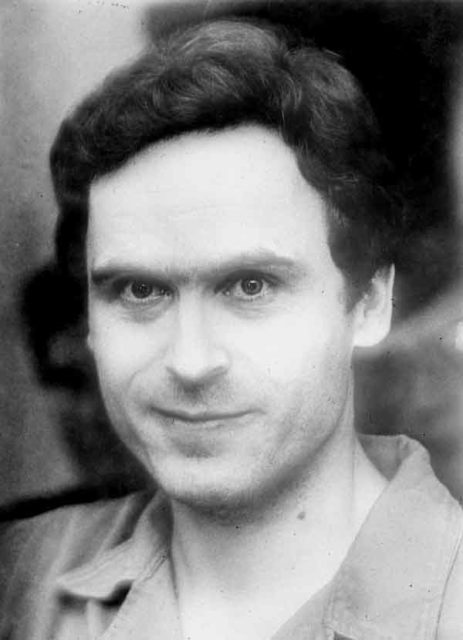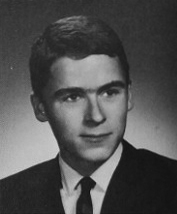Many people who personally knew Ted Bundy in the 1970s found him a charming young man who seemed motivated and highly intelligent. He was a law student in Washington state with moderate Republican views. Some felt he had a future in politics, and could go as far as governor.
Yet this same Ted Bundy is responsible for the kidnapping and cold-blooded murders of at least 30 women, not only in Washington but across several other states until he was finally caught in Florida, tried and convicted, and sentenced to death in 1989.
Bundy has always been fodder for books and movies, most famously Ann Rule’s The Stranger Beside Me, and Stephen G. Michaud and Hugh Aynesworth’s The Only Living Witness and Ted Bundy: Conversations With a Killer, and the 1986 television movie The Deliberate Stranger, which starred Mark Harmon. Interest has not died down, either. A new film on Bundy is in the works, with a top director and cast.
Born in Burlington, Vermont, in 1946, Theodore Robert Bundy, as his full name went, did not have the best childhood, most definitely. His mother, Eleanor Cowell, gave birth to him out of wedlock during a time when that was a disgrace to a family. With the intention of protecting Ted from bullying or people treating him as an outcast, Eleanor’s parents pretended to be the parents of Ted for at least seven years and his mother pretended to be his big sister.

The Cowell household was not peaceful. Ted’s grandfather was well-known as a nasty bigot and a heavy drinker. (A dark theory has it that Ted’s grandfather was his biological father.) Ted himself would eventually grow up to be an antisocial teenager, deeply influenced by the effects of pornography. He gained a long record of theft with the police, which was wiped when he reached 18.
Bundy received his psychology degree in 1972 at the University of Washington, and at the beginning, he showed his aspirations to move up the ladder in politics and law. Such plans were at one point abandoned, but his friends and girlfriends had no idea that Bundy had commenced with his vicious assaults on women, taking the life of his first victim as early as 1972.

In his college years, interestingly enough, Bundy took on assignments such as volunteering at a suicide-prevention hotline, as well as being enrolled at the state’s crime-prevention task force, so as to prepare for his career in law and politics.
Ted’s colleagues at the suicide line would note that he was good at the job. One of them was Anne Rule, the future bestselling writer of true crime. She said Bundy used to walk her to her car late at night to make sure she was safe. She was astounded by his later arrest, saying, “Ted Bundy took lives, but he also saved lives.” Others wonder, did the suicide line allow him to explore the vulnerabilities of distraught people? And did he learn through the task force how law enforcement functions and how officials and investigators trace criminals around the country?

The year after college, Ted Bundy would enroll at law school at the University of Utah, though he’d frequently miss classes and eventually stopped going to school completely. Several women went missing in the area, some of whom were students at the same university Ted had attended.
Several people would testify that the missing women were last seen in the company of a good-looking young man. The name “Ted” was heard. More accounts tell that Bundy not only employed his charm but other cunning strategies. To some victims, Bundy would supposedly introduce himself as disabled, asking them to help with loading groceries or climbing stairs. To others, he would approach as if he were a policeman, gaining their trust until the moment of trapping them and finally taking their life.

Bundy bludgeoned the women, strangled them, raped them, and sometimes torturing them. Bundy’s sadistic urges did not cease there, as many times he would return to sites where he had dumped the bodies to continue his depravity, while the decapitated head of the tragic victim could be exhibited in his apartment as if it were a piece of furniture.
As the number of victims steadily grew, there were several instances when people reported Bundy as the suspect. His own girlfriend notified the police that he fit the description. Thanks to his wholesome image, the police dismissed Ted Bundy from suspicion. But there was also the fact that he did not leave any traces of evidence at the scene of the crime, an aspect that continually helped Bundy stay off the suspects list.

Ted Bundy was arrested on August 16, 1975, after police noticed him suspiciously cruising through a neighborhood. When the police officers searched his 1968 Volkswagen Beetle, they found a plethora of incriminating items, such as ropes and handcuffs. Still, there was nothing inside that provided direct connections to the crimes.

Though the police did not charge Bundy at this time, they made sure to monitor him. Things escalated as one of Ted’s next victims managed to escape; this time he was charged. When he was arrested, it was for aggravated kidnapping and attempted criminal assault. He was found guilty and sentenced, but by this time Colorado wanted him in connection with a murder.
Ted Bundy was transferred for trial in Colorado, where he found a way to escape jail but only for a week. However, in 1977, Bundy escaped the police once again, this time fleeing to Florida, where he shockingly claimed the lives of another six victims, five of whom were university students.

Ted Bundy did not stay free for long. The next time he was caught, Ted Bundy was set for the long years of the many trials to follow. Initially, he struggled to prove he was innocent, until he changed his strategy and started to confess to some of his crimes. Bundy allegedly did this only to buy some time, so as to avoid the inevitable, which was a death sentence. He insisted that he could offer the world information on why he became a killer that would help authorities understand the process.

The psychologists and criminologists who’ve studied Bundy in person or through interviews believe he was a genuine psychopath, incapable of feelings of sympathy or remorse. Another diagnosis is antisocial personality disorder.
Execution finally took place in Florida on January 24, 1989, with the electric chair.
It is estimated that the number of innocent lives Ted Bundy took was many more than 30, perhaps in the hundreds as some accounts suggest.
Nearly three decades after Ted Bundy’s death sentence, it was announced that a new film production is set to tell the story of the killer, now set from the perspective of his long-term girlfriend, Elizabeth Kloepfer. Entitled Extremely Wicked, Shockingly Evil and Vile, the film will be directed by Oscar-nominated filmmaker Joe Berlinger. Zac Efron will star as Ted Bundy.
